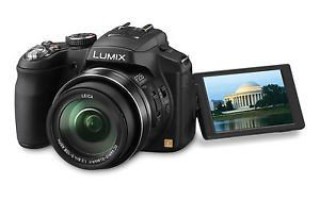Panasonic Lumix FZ200 Review
Panasonic Lumix DMC-FZ200 - a digital camera with a DSLR angle

![]()
God of Reviews
Updated: January 7, 2016
It’s not always convenient to take a full-fledged DSLR with you (I have an old one, but I love it and it’s pretty shabby due to the frequency of use). That is why many amateurs who bought the same DSLR for home needs sooner or later think that it would be nice to have something more compact, but no less high-quality in terms of the output material. I am one of those who thinks about this very, very often, but so far I can’t get my act the financial side.
I “had to” delve more deeply into the advantages and disadvantages of some digital camera models in the process of selecting and ordering a camera for a friend who, like me at one time, wondered about providing an alibi for high-quality home photo archive. In the search, the obligatory items of parameter and function requirements were:
- High photo quality;
- Availability of video recording;
- Good brand authority.
At one time I didn’t think about the fact that a camera must have a video mode, but now sometimes I regret that my D70 doesn’t have it. It was necessary to evaluate the advantages (or rather the disadvantage of the absence) of video filming very quickly - after all, the camera was taken primarily to capture the child. And a photo cannot always convey (remember) what he said, how he walked, how he laughed, etc... so now I understand that video is an integral part of the archival component of our life =)
Terms of purchase, delivery, etc.:
To tell the truth, I did not help search for the right ad and model, I only shared my feelings from the experience of using Nikon equipment (they, by the way, are the most positive!). I’m not a professional photographer, and in the vast majority of cases I shoot in auto mode with preset parameters, and only occasionally switch to manual settings. My friend didn’t want a DSLR, because... However, it is large and carrying it with you is not always convenient or advisable. The final choice was made between three models, but the “winner” was Panasonic Lumix DMC-FZ200 , which, judging by reviews not only from online users, but also from friends, is the best option for home use in the price segment up to $300.
We paid $297.99 for the camera, free shipping in America was chosen, and delivery to us was already $8.8. Additional expenses - checking the contents of the parcel and additional packaging - another $9, the intermediary's commission was 10% of the order amount. Insurance was not taken out (although if I had made a purchase of this kind, I would not have saved on insurance).
Description of Panasonic Lumix DMC-FZ200 Digital Camera:
Lens – focal length 25-600mm, 24x optical Zoom, F2.8 aperture;
Matrix – CMOS type, total and effective pixels, respectively – 12.8/12.1 million, ISO 100-3200 + Auto-adjustment, maximum image resolution 4000x3000;
Flash – built-in, with a range of up to 13.5 m, + you can attach an external (external) additional one. flash;
Focusing – auto + manual, minimum distance (normal shooting and macro, respectively) 30/1cm;
Display – LCD screen, rotating, diagonal – 3 inches, resolution – 360 pixels;
Memory – built-in 70MB, + reading SD, SDHC, SDXC memory cards;
Video – AVCHD formats (MPEG-4 / H.264), duration depends on the amount of available memory, resolution 1920x1080. Sound recording - yes;
Power supply – DMW-BLC12 battery, capacity 1200 mAh;
Dimensions – 12.5 x 8.7 x 11 cm, weight 588 grams.
I don’t see any point in listing all the available characteristics and functional set of the camera, because... the Internet is full of broader and more information-laden descriptions, but I have provided the most important list.
As for the camera itself - it’s relatively light (I compare it with mine, so it’s like a feather to me =), the assembly is high-quality, the plastic is dense - in principle, there’s nothing to talk about here, because The camera is not from the “soap box” series, but a more serious technique.
The kit includes: battery, charger, camera itself, shoulder strap and lens cap. The lens hood was already purchased separately and in an offline store.
About the design and features of the “anatomical structure” of the camera - a very convenient and comfortable (and reliable!) fit in the hand. Quite a deep handle and finger groove. Materials, as standard - with a leather-like bevel, in fact - the inserts are made of rubberized material (not at all slippery to the touch)
The first tangible advantage is the rotating screen, which you can rotate as you please. The advantage is that even in the brightest daytime sun, and with reflections from the snow-white snow, you can rotate the display so that you can see everything that is happening and the camera’s field of view.
Leica lens with one movable arm (telescopic).
At the top there is a socket (hot shoe) for installing an additional flash. The built-in one opens as standard - at the first click of the shutter button, microphones are located next to the native flash
As for the control panel, everything is more than simple and accessible. By and large, you can figure out the basic and elementary functions without a manual.
Memory media and battery are inserted in the same division/compartment (but, of course, in different slots)
As for the connectors intended for connecting the camera, there are only two of them - HDMI mini and USB port
As an example of the camera's capabilities, I attach several photographs taken at different (or rather, all available) ISO values. I hide the photo under a spoiler so as not to clutter the review with a bunch of similar photos =)
To show the quality of the video, I am attaching it just below (the camera has already been on vacation and showed its best side =) in my opinion - the most amazing detail and quality (but this is IMHO, and nothing more)
In general, I think that for home use, this camera is one of the favorites and ideal options among the others (I even wondered, to be honest, if they should sell me a DSLR). But then I abandoned the idea, it would be better a little later to fork out for a second camera, but not a DSLR, but an ordinary digital camera, but with very bright and impressive characteristics and final results on the source =)
Panasonic LUMIX DMC-FZ200 - an example of a proper update
Sergey Verveyko
| December 27, 2012 |
The zoom ratio of the Panasonic LUMIX DMC-FZ200 compared to modern ultrasonics is not only unimpressive, but even surprising. Just 24x - nowadays even ultra-compacts, for example, Olympus SZ series or Samsung WB series, are capable of this. But don't rush to conclusions. Both the FZ100 and FZ150 were equipped with the same lens with two aspherical elements (3 aspherical surfaces) and an aperture of ƒ/2.8–5.2, which is actually quite good for an ultrazoom. But the new product uses a lens with 5 aspherical lenses (9 aspherical surfaces) and, most importantly, a constant f/2.8 aperture throughout the entire focal length range.
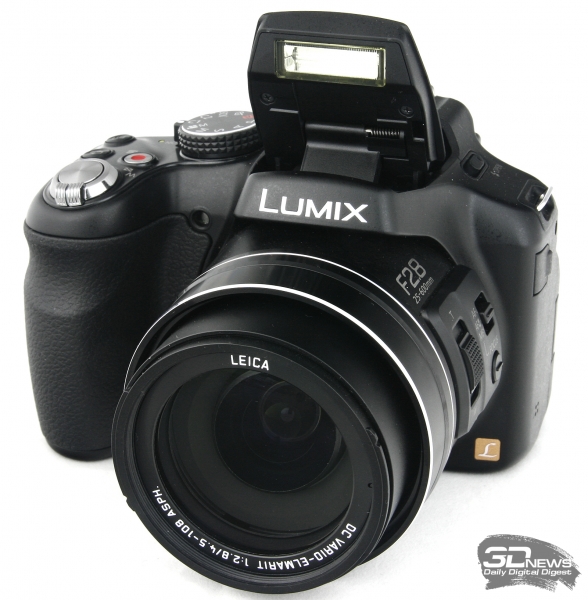
It's no secret that shooting in cloudy weather or in low light with an ultrazoom when setting the maximum focal lengths with the aperture clamped to ƒ/5.6–6.5 is quite difficult. You have to raise the sensitivity level, and the noise level increases accordingly, which is especially noticeable in the case of a small matrix. But the camera under test does not have such problems at all, and the advantage of almost two stops is worth a lot. In addition, the menu has been significantly redesigned, but more on that below. In general, an outwardly unnoticeable upgrade, but the FZ200 is a qualitatively new camera, while the FZ150 was nothing more than a restyling.
⇡#Technical characteristics declared by the manufacturer
| Panasonic LUMIX DMC-FZ200 | |
|---|---|
| Image sensor | CMOS 1/2.33″, 12.8 MP |
| Effective number of points | 12.1 MP |
| Image saving format | Still image: JPEG (EXIF 2.3, DCF), RAW, MPO (3D) Video: AVCHD, MPEG-4 |
| Frame size in pixels | Photo frame: [1:1] 2992×2992 (9M), 2448×2448 (6M EZ), 1920×1920 (3.5M EZ), 1536×1536 (2.5M EZ), 480×480 (0.2M EZ ) [4:3] 4000x3000 (12M), 3264x2448 (8M EZ), 2560X1920 (5M EZ), 2048X1536 (3M EZ), 1600x1200 (2M EZ), 640x480 (0.3M EZ) [ 3:2] 4000×2672 (10.5M), 3264×2176 (7M EZ), 2560×1712 (4.5M EZ), 2048×1360 (2.5M EZ), 640×424 (0.3M EZ), [ 16: 9] 4000×2248 (9M), 3264×1840 (6M EZ), 2560×1440(3.5M EZ), 1920×1080 (2M EZ), 640×360 (0.2M EZ), 1920×1080 (3D) Video : up to 1920x1080 pixels 60p (PSH: 28 Mbps / AVCHD) |
| DPOF | DPOF support |
| Sensitivity, units in ISO equivalent | 100, 200, 400, 800, 1600, 3200, 6400 |
| Lens design | LEICA DC VARIO-ELMARIT 14 elements arranged in 11 groups, including 3 ED lenses and 5 aspherical lenses with 9 aspherical surfaces |
| Focal length range, mm | 4.5–108.0 (25–600 35mm equivalent) |
| Diaphragm | ƒ/2.8–f/8.0 across the entire focal length range |
| Digital zoom | Up to 4x (up to 50.6x with optical zoom) |
| Focus range, m | 0.3 to infinity (0.01 in macro mode) |
| Exposure, s | 1/4000–60 |
| Exposure metering | Multi-zone, center-weighted, spot |
| Exposure compensation | +/-3 EV in 1/3 EV increments |
| Scene modes | 17 scene programs, automatic recognition |
| White balance | Auto, Daylight, Cloudy, Shade, Halogen, Set white, select color temperature. |
| Built-in flash | Eat |
| Flash Modes | Auto, Red-eye correction, Slow sync, Forced on/off |
| Flash range (sensitivity Auto), m | SHU: 0.3–13.5 Tele: 1–13.5 |
| Self-timer, s | Delayed 2/10 |
| Storage device | SD, SDHC, SDXC |
| Built-in memory, MB | 70 |
| LCD display | 3.0″ color LCD, 460,800 dots |
| Interface | miniHDMI, USB, audio/video output |
| Nutrition | Li-ion battery DMW-BLC12E (included), 8.7 Wh |
| Dimensions (WxHxD), mm | 125,2×86,6×110,2 |
| Weight (excluding accessories), g | 537 |
⇡#Supply set and options
Standard delivery includes:
- data cable;
- battery;
- Charger;
- lens cap with fastening cord;
- belt;
- CD with software (PHOTOfunSTUDIO 8.3 PE, SilkyPix Developer Studio, Adobe Reader).
An impressive list of options is also offered: not only cases, belts and various cables, but also external flashes, including “adult” GN36 and GN50, polarizing, protective and neutral gray filters, a wired remote control, an external microphone with a hot shoe mount, as well as wide-angle and tele-converter.
⇡#Appearance and ease of use
The only significant difference in appearance between the FZ150 and the FZ100 was the group of controls on the left side surface, where, in addition to the focus mode selection lever and the focus key, an additional zoom control slider appeared. At first glance, the design of the FZ200 has also not changed, but there are still differences. Firstly, the flash lock key has moved to the upper part of the body, and in its place is a button for switching between the display and viewfinder. There have also been a few castlings to the right of the screen, but the main difference is the addition of a programmable key. The control unit in the upper part of the body has also been changed. Instead of the usual sliding power switch for Panasonic cameras, there is a lever coaxial with the shooting mode dial; in addition, an additional programmable key has appeared.
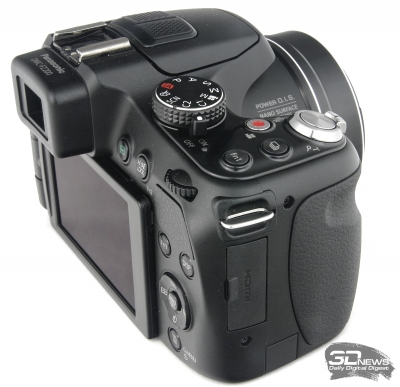
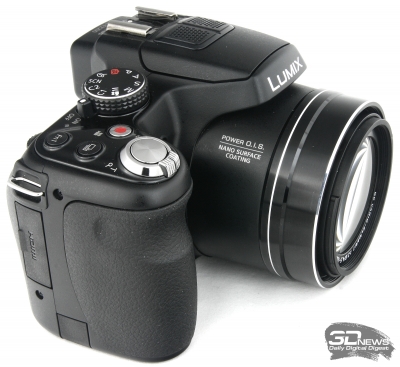
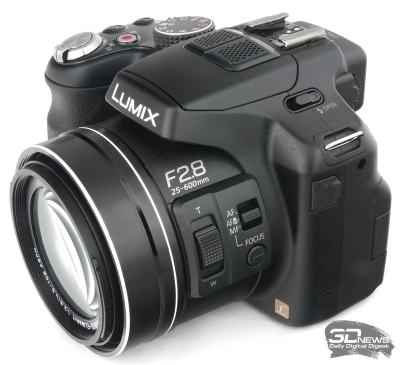

The build quality of the case, as before, is very high; the assembly is Japanese. Considering the degree of automation of today's assembly lines, the latter is nothing special, but still somehow warms the soul. The camera has become a little larger, although without direct comparison it is quite difficult to notice. The weight of the device has practically not changed at all. The F200 feels comfortable in the hand, but the rubber grip on the front is quite slippery, so extra care would be a good idea when using the camera without a strap.
At the front are only the lens and the autofocus LED.

On the back wall there is a rotating screen, a viewfinder, a key for switching between them, as well as buttons for switching to viewing mode and autofocus/exposure locking (the latter is programmable). To the right of the screen there is a dial key (pressing the dial opens the exposure correction menu), a programmable key and a key for changing the display operating mode, a round multifunction key with an enter button in the center, and at the very edge there is a delete button and the same one for calling up the quick menu and returning to one level back.

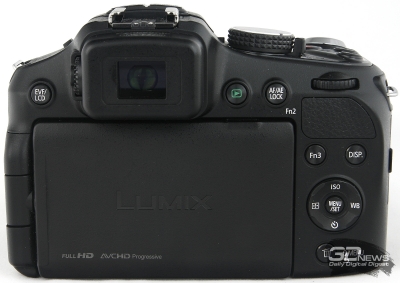
On the left side surface there is a zoom control slider, a focus mode selection lever, a focus key, and a connector for connecting an external microphone is hidden under a rubber plug.

The right side surface is less loaded. The only thing visible here is a rubber plug, under which the HDMI and USB/AV cable connectors are hidden.
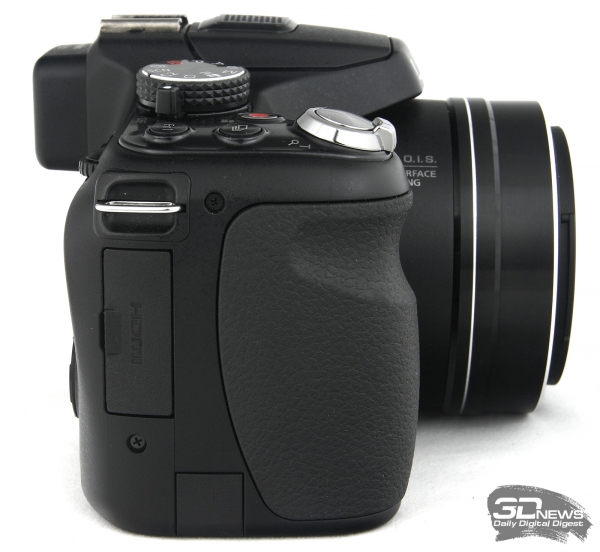
The upper part of the body is quite heavily loaded. There is a pop-up flash with stereo microphones and a hot shoe built into the base. To the right of the flash are a shooting mode dial, a power switch, a video button, a drive mode button, a programmable button, and a shutter button surrounded by a zoom control lever.

At the bottom there is only a tripod mount connector and a door that hides the battery and memory card compartments.
Ultrasound for perfectionists. Video review of Panasonic Lumix FZ200
Testing a camera like this should be detailed and thorough, but we wanted to talk about it as soon as possible, so we made a video review as a starter.
The Lumix FZ200 doesn't try to be just a compact camera. On the contrary, it shows with all its appearance that it is intended for demanding amateurs who know a lot about digital photography. I don’t think that the main marketing advantage of this model will be appreciated by amateurs. This is a constant aperture throughout the entire range of focal lengths, f/2.8. The range is very impressive: from 25 to 600 millimeters equivalent. Overall, 24x optical zoom. Most analogues boast f/5.6, or even f/6.3 at the long end. And despite sophisticated stabilization systems, it is possible to shoot at maximum zoom only in ideal conditions. The Lumix FZ200 even with the stabilizer disabled (of course, it also has one) performs better.
General view of Panasonic Lumix FZ200
Panasonic Lumix FZ200 tilt/tilt screen
From its face, the FZ200 can be mistaken for an inexpensive DSLR. Or even behind the Lumix G system camera, but if you look at the body at an angle you will notice that the lens is not replaceable. The control scheme is familiar. There is also a convenient joystick on the rear panel, there is a three-position scroller under the thumb, as well as a large tilt-and-swivel display and an electronic viewfinder. Zooming is carried out either by the usual lever framing the shutter button, or by a vertical slider on the left side of the body. This can be perceived both as a concern for left-handed people and as an additional convenience when holding the camera with two hands. Something similar has already been seen in the Nikon Coolpix series ultrazooms, as well as in some models of Olympus compact cameras.
Top panel of Panasonic Lumix FZ200
Panasonic Lumix FZ200, three-quarter view
The electronic viewfinder has a resolution of 1.3 megapixels, but in most cases it is more convenient to aim across the screen. By the way, autofocus is quite fast, regardless of the chosen focal length. The only thing we noticed at the preliminary testing stage was uneven zooming at wide angles.
The matrix resolution is 12 megapixels, which corresponds to a size of 4000x3000 pixels. Naturally, it is possible to shoot in RAW format. And video can be recorded in AVCHD format at 60 frames per second and a resolution of 1920x1080. The sound is recorded in stereo mode - for this purpose there are two microphone grilles on the upper side of the case.
But the picture quality at high ISO values was a real revelation. Sensitively 1600 units is quite working. And although the noise is already noticeable, the dynamic range is narrowed slightly - you can even shoot high-contrast scenes.
The back of the Panasonic Lumix FZ200
Panasonic Lumix FZ200 awaiting testing
The Lumix FZ200 has 70 megabytes of built-in memory - enough to test the camera before purchasing, and uses an SD/SDHC/SDXC card up to 64 gigabytes as the main storage device. There is no memory card included, you will have to buy it separately. But the box carefully includes a small cord that secures the lid to the body, as well as a convenient lens hood that eliminates side light from the front lens and possible spurious reflections.
Well, on one battery charge we managed to shoot about 600 frames, this is a very decent figure even for SLR cameras, not to mention compacts.
Overall, the Lumix FZ200 makes an extremely pleasant impression. However, we will draw final conclusions upon completion of testing and publication of a detailed text review.

